INTERVIEW: New documentary ponders the sky in Atacama
Photo: Alison McAlpine’s Cielo looks at the sky above the Atacama Desert in Chile. Photo courtesy of Juno Films, Inc. / Provided by Film Forum press website with permission.
Chile’s Atacama Desert comes into fine focus in the beautifully stirring new documentary Cielo, from writer-narrator-director Alison McAlpine, who is making her feature-length debut. The movie — running a quick, yet transfixing 78 minutes — is currently playing New York City’s Film Forum.
The documentary mostly trains its eye on the skies above the Atacama, showing the audience the heavenly marvels of the Milky Way and network of stars on view. Using time-lapse cinematography, the audience is treated to a visual splendor that can be simultaneously dizzying and awe-inspiring.
There are so many adjectives that can be used to describe Cielo: emotional, immense, spiritual, humbling. McAlpine and her team capture it all, and they also add the human element by following scientists who look at the Atacama skies for a living and the locals who gaze upward on a nightly basis.
“I was in Chile pursuing another possible film project on an observatory that’s creating the biggest digital camera in the world, and I went away for a weekend to a little village in the southern Atacama,” McAlpine said in a recent phone interview. “And I was working outside this village at night, and it happened to be a night without a moon. And all of a sudden the lights went out in the village, and I looked at the sky. I had never seen a sky like that in my life. I was overwhelmed by the beauty of the sky, and I felt this extraordinary freedom inside. And I was full of so many questions, and I was moved tremendously by the beauty I saw. And in short I realized one of my questions was about myself and most of us who live in cities and how we don’t see the sky anymore in our daily lives.”
Before gathering her crew members, the director spent a couple of years finding the characters she wanted to follow. She wanted to earn their trust so that their time on screen seemed natural and real. Then the actual filming — of the arid land, the majestic skies and the interesting people — took one full calendar year.
“We filmed throughout a year, but at different parts of the year,” she said. “So there were different shoots throughout the year and then different time lapses, which some of them I did myself. Some of them I did with another Chilean friend. It was done because of weather and schedules during different times of the year. In the northern Atacama, it’s a different climate than the southern.”
To earn the trust of the locals, who call this high-altitude setting home year round, she spent a long time making friendships and listening. “Always I spent a lot of time because I wanted intimacy and humanity,” she said. “I developed friendships with these people and trust so they would feel absolutely natural in front of the camera, which I hoped they did.”
McAlpine and her director of photography, Benjamin Echazarreta, used Sony a7S and a7S2 cameras for the time-lapse footage. They used a different camera for the scenes that depicted people looking at the stars. The timing was key on these shoots because they needed some light in the sky, so they waited until five to seven days before or after a new moon.
“I didn’t want any tricks of dollying,” she said. “We used a motion-control system, but a very simple one twice to follow the moon that was setting and the rise of the Milky Way. But mostly I wanted something as human, as organic in terms of texture.”
She added: “You have to go to the right places. You have to go away from any village. Any city [must be] a long way away. You have to watch the sky at the right time so you can see the Milky Way. There’s parts of the year you can’t see the Milky Way, so you have to time your seeing accordingly. But it’s extraordinarily intense. I’ve never seen a sky so beautiful, so alive as I’ve seen the sky in Chile.”
The images captured in Cielo are technically above everyone in the world at different times of the year, and yet because so many people live in metropolitan areas with light pollution, the images seem rare and unique, almost extraterrestrial, as if they are from another world. That makes Cielo so important to see because it reveals what is hiding behind the guise of development, technology and so-called progress. The film honors an experience for humans that seems almost lost.
“It feels very special to me and rare because in the city we can’t see the sky in any profound way,” she said. “It’s not just the beauty of the sky, but the visceral, emotional connection one can feel. This is where I felt I was inside the sky for the first time in my life — not that the sky was above, and I was below it and I was on this horizontal, flat plane, which is what you feel like in the city. You also feel the rareness of it. You feel this vertical space in the desert and that you’re on a planet that is moving. There’s something that is part of the experience. It’s also the silence. There’s an absence of what we call sound in the city. The desert is so silent. It’s hard to pick up the sounds for the microphone, so I think that also contributes not only to the catalyst for the contemplation and reflection, but also the experience of focusing on the sky.”
By John Soltes / Publisher / John@HollywoodSoapbox.com
Cielo — written, narrated and directed by Alison McApline — is currently playing New York City’s Film Forum. Click here for more information and tickets.

